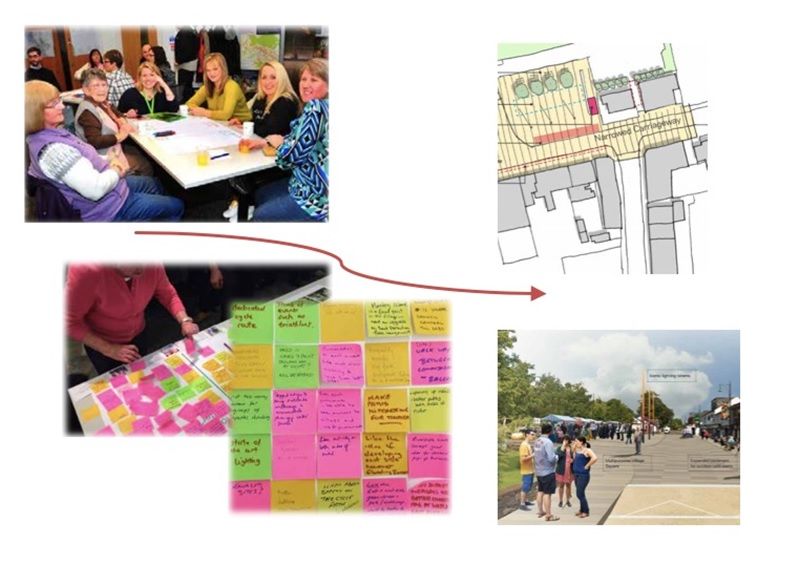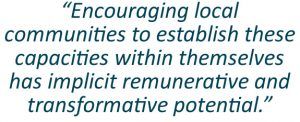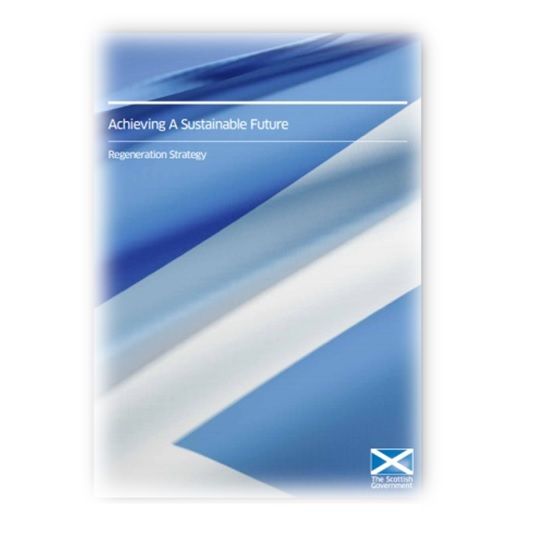SURF and our wider network have taken a keen interest in the potential of community Charrettes as a means to facilitate community participation in local regeneration decision-making. In this context, PhD researcher Michael Kordas provides highly useful insights on Charrettes in practice and the role which they might play in long-term regeneration strategies.
Today’s Scottish planning system is expected to balance many responsibilities: implementing sustainable economic growth, delivering across a wide range of social and community outcomes and involving communities in both the formulation and implementation of development plans.[i] These issues are also central to Government’s aspirations for ‘community led regeneration’, where local people identify “the issues and opportunities in their areas and take responsibility for delivering action that will make a difference”.[ii] This focus on the grassroots parallels the winding-up of Scotland’s official urban regeneration companies, with only Clyde Gateway remaining, underpinned by the Glasgow 2014 legacy.[iii]
What is Government doing to support regeneration then? Although not so explicitly advertised, I would argue that the Scottish Sustainable Communities Initiative (SSCI) Charrette Mainstreaming Programme is an important venture in this respect, by providing funding to encourage participation in spatial and community planning.[iv] As a policy transfer[v] from the USA, the ‘charrette’ is an intensive series of interactive workshops between citizens and built environment professionals.[vi] 2015-16 saw the Programme emphasise the role of third sector organisations organising these events directly, or facilitating communities to scope a vision and projects with the aim of improving the quality of their places.[vii]

Images from Charrette in Balloch, West Dunbartonshire. Source: (7N Architects / Loch Lomond & the Trossachs National Park Authority)
To investigate the potential role of the Charrette in this capacity, the work of Pierre Bourdieu [viii] is especially valuable. His conception of cultural and social ‘capital’ as capacities possessed by certain individuals and groups, both to express and represent themselves effectively and form interrelationships with others, has become a cornerstone on regeneration issues.[ix] Encouraging local communities to establish these capacities within themselves has implicit remunerative and transformative potential.[x] However, it is also important that communities are not left to overcome what may be entrenched structural problems single-handed.[xi]
Charrettes in Practice

My most recent research[xii] investigated the role of third sector organisations and community trusts organising charrettes in light of the recent developments in SSCI. The project was based on interviews and ethnographic observation within four case study events from 2015-16. The findings highlighted the advantages held by these groups: be it their local connections or not-for-profit status, which render them more approachable than public authorities in conducting dialogue within communities. Nevertheless, questions were raised as to whether the charrette may be the most appropriate initiative to create this conversation in all settings.
These concerns were most pertinent considering two of the case studies took place in settlements incorporating datazones ranked amongst the most deprived 10% on the Scottish Index of Multiple Deprivation (SIMD).[xiii] In marked contrast to experience in the more affluent settings covered by the study, it was extremely difficult to get local people ‘in the door’ of the charrette space to discuss the issues facing their community. The volunteer led facilitation team was thus compelled to take to the streets to do so. Tellingly, a number of potential participants within these settings expressed intimidation at the prospect of making their voices heard in a room full of professionals.

Current Regeneration Strategy aims to achieve “community led regeneration”. Source: (Scottish Government, 2011)
Role of Social Capital
What comes across most strongly then, in light of the different ‘balances’ of social and cultural capital between places, is that some localities need particular support if community led regeneration is to be realised through charrettes. In this respect, SSCI and its successor Design Charrette Fund may present challenges. Facilitators are committed to one intensive and short term form of intervention. The funding application process is also a competitive one, requiring a good deal of policy literacy and understanding. This could represent a barrier to those communities, especially in more deprived settings, which might lack this particular experience.
Charrettes in Regeneration Strategy
In light of these issues, SURF’s recent policy recommendations are helpful.[xiv] A key suggestion was defining a more strategic context for regeneration in Scotland, designating and investing in 15 significant places for action according to SIMD position. Such an approach would not involve designating new bodies, instead drawing on the capacities and resources latent in local authorities and other public and third sector organisations working together. Taking a long view of regeneration in this way would also leave space to consider complimenting charrettes with other participative approaches.[xv]
As Scotland nears the end of this decade in a time of political and economic uncertainty, these ideas could be highly useful to Government in considering a regeneration strategy with which to approach the 2020’s.
Reference List
[i] Scottish Government. (2014). Scottish Planning Policy. Edinburgh: Scottish Government
[ii] Scottish Government. (2011). Achieving a Sustainable Future: Regeneration Strategy
Edinburgh: Scottish Government, p.20 , author’s emphasis
[iii] Clyde Gateway (2016). Making a Difference: Regeneration Activities 2016.
(Online) Glasgow: Clyde Gateway.
Available at: http://www.clydegateway.com/wp-content/uploads/2016/06/Making-a-Difference-Brochure-website-version.pdf
(Accessed 22 December 2016)
[iv] Scottish Government. (2015b). Charrette Reports 2013-2014. (Online) (Last updated 11 May 2015)
Available at: http://www.gov.scot/Topics/Built-Environment/AandP/Projects/SSCI/Mainstreaming/reports2014
(Accessed 02 October 2014)
[v] Dolowitz, D., (2000) Policy Transfer and British Social Policy.
Buckingham: Open University Press.
[vi] National Charrette Institute. (2016). NCI Frequently Asked Questions.
(Online) (No date last updated) Available at: http://www.charretteinstitute.org/FAQ.html#3
(Accessed 11 March 2016)
[vii] Scottish Government. (2015c). SSCI Charrette Mainstreaming Programme.
(Online) (Archived) (Last updated 07 September 2015) Available at: http://www.gov.scot/Topics/Built-Environment/AandP/Projects/SSCI/Mainstreaming (Accessed 24 May 2016)
[viii] Bourdieu, P., (1986). ‘The Forms of Capital.’ In Szeman, I. & Kaposy, T., (eds.) (2011). Cultural Theory: An Anthology. Oxford: Wiley Blackwell. Ch8.
[ix] Milbourne, L., (2009). ‘Remodelling the Third Sector: Advancing Collaboration or Competition in Community-Based Initiatives?’ Journal of Social Policy Vol.38 (2), pp.277-297.
[x] Mandarano, L., (2015). ‘Civic Engagement Capacity Building: An Assessment of the Citizen Planning Academy Model of Public Outreach and Education’. Journal of Planning Education and Research. Vol.35 (2), pp.174-187.
[xi] Dicks, B., (2014). ‘Participatory Community Regeneration: A Discussion of Risks, Accountability and Crisis in Devolved Wales’. Urban Studies 51 (1), pp.959-977.
[xii] Kordas, M. (2016) Space for a Third Force? Third Sector Organisations and Community Engagement in Planning. Unpublished MRes. Dissertation: University of Glasgow.
[xiii] Scottish Government (2016) SIMD Scottish Index of Multiple Deprivation 2016.
Online (No date last updated)
Available at: http://simd.scot/2016/#/simd2016
(Accessed 22 December 2016)
[xiv] Scottish Urban Regeneration Forum (SURF). (2016). SURF’s 2016 Manifesto for Community Regeneration. Glasgow: SURF.
[xv] Sanoff, H. (2000) Community Participation Methods in Design and Planning.
New York: John Wiley and Sons.

